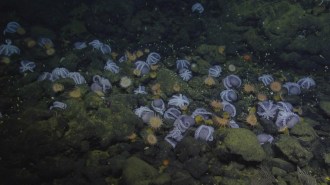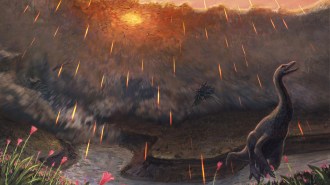Search Results
Seeing faces everywhere
Ever seen a face in the moon? Or a slice of toast? What about the front of a car (and not just the characters in the movie Cars)? If so, you’re in good company. Many people see faces in commonplace objects. After learning about face pareidolia, the phenomenon of seeing faces in everyday objects, students will collect images of faces they find in nature and inanimate objects and then poll classmates on the perceived gender of the faces. Students will compare their results to results from a study reported in Science News and then design their own follow-up research on face pareidolia.

Deep-sea ‘Octomoms’ Seek the Heat
In this guide, students will answer questions about how scientists discovered that octopuses laying eggs in warm waters near geothermal springs are speeding up hatching. Students will then define rates and their units of measurement for biological and chemical processes and discuss factors that affect rates.
Octopus moms seek the heat
Students will answer questions about the Science News article “Some deep-sea octopuses aren’t the long-haul moms scientists thought they were,” which describes how octopuses laying eggs in warm waters near geothermal springs speed up hatching. A version of the article, “Deep-sea ‘octomoms’ seek the heat,” appears in the April 9, 2022 issue of Science News.

The Age of Dinosaurs May Have Ended in Springtime
In this guide, students will answer claim, evidence and reasoning questions about how scientists used the bones of ancient fish to determine during what season an asteroid wiped out nonavian dinosaurs. They will then explore the physical properties of human bones and how bones offer evidence to support scientific claims.
Dating dino doomsday
Students will answer claim, evidence and reasoning questions about the online Science News article “The Age of Dinosaurs may have ended in springtime.” The article describes how scientists used fossilized fish to determine what season it was when an asteroid wiped out nonavian dinosaurs. A version of the article, “Dinosaur killer may have hit in spring,” appears in the March 26, 2022 issue of Science News.
Dig into bones
Students will discuss the physical properties of human bones and how bones can offer evidence to support scientific claims. Then students can search Science News for examples of how bones have been used as evidence.
Examining bias through fossils
Students will learn about early evidence for human evolution, discuss how interpretations of data can be influenced by scientists’ biases and develop a framework for analyzing the physical features of hominin fossils.
Thinking through climate solutions
Students will research how climate change affects a nonhuman species, propose science-based solutions that might lessen the impact of climate change on the species and create an infographic to share with the class.
- Exercise type:Activity
- Topic:Health & Medicine
- Category:Coronavirus
- Category:Data Analysis
- Category:Diversity in STEM
A fair shot
Students will analyze a graph to identify inequities in COVID-19 vaccine access among nations based on wealth, discuss how affluence affects access to and distribution of vaccines as well as how disparities in vaccine distribution affect global pandemic recovery. Students will then work in groups to research COVID-19 vaccine access and distribution in their state or local area, identify potential inequities in vaccine access and distribution and construct a graph of their own.
Creating a vascular plant’s ecological niche
Students will learn about the ecological niche concept, conduct online surveys of vascular plants found in a biodiverse region of South Africa, conduct field surveys of vascular plants found in a local ecosystem and present a poster describing the ecological niche for a vascular plant of their choice.
Visual models for how a virus spreads
Students will analyze visual displays of data about clusters of coronavirus cases and work in groups to develop their own visual model of virus spread. Then, students will discuss how the way data are displayed affect data interpretation, and how the displays might inform public health decisions.
Sizing up a dinosaur
Students will answer questions about the Science News article “This ancient dinosaur was no bigger than a hummingbird,” which reports on a fossil of a many-toothed, Mesozoic predator.